Conservitive Suit Colors Mens Frugal Fashion
If you want to know what men really thought of mode in the roaring twenties, all you take to do is look at the history of men's 1920s suits. Information technology is the one item of habiliment every man wore on a daily basis. The rich had closets full of suits of every style, color, and fabric, while the working poor may accept had only one proficient suit to wear to church on Lord's day and mismatched conform pieces to wear during the week.
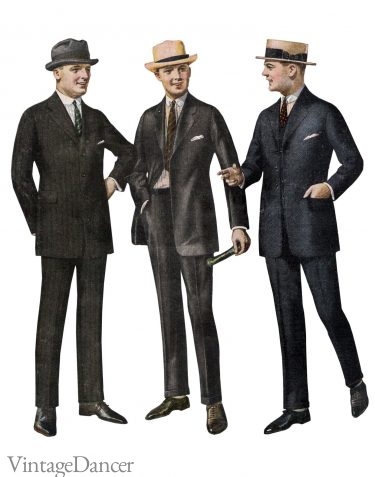
1922 men's suits
1920s Men's Suit Styles
The 1920s fashion suit is one that is divided into not one but two styles that bridge the decade. The showtime few years had men in narrow fitting "jazz" suits and slightly less slender lounge suits, while the remainder of the decade had men wearing broad fitting suits. By 1925 the transition from slim to wide was complete.
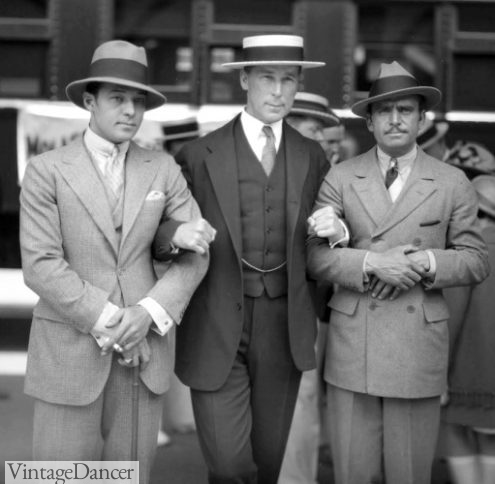
Actors Rudolph Valentino, WS Hart, Douglas Fairbanks 1925
The Jazz Conform
When men returned from WW1 they put put on their slim pre-state of war suits and went near their new/sometime life. The but problem was that they were now in much better physical condition and their old suits fit even more snugly. Between 1918 and 1923 the Jazz Suit was described as "sausage casing" for young men.
Older men as well as virtually young men who didn't follow farthermost fashions, were still wearing the somewhat baggy styles of the late 1900s, although they had been slimmed downwards during the state of war every bit shortages of textile and dye limited production.
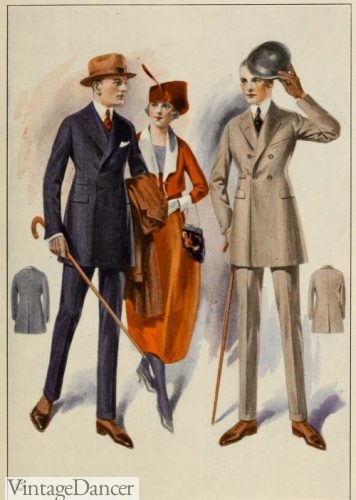
1921 young men's double breasted Jazz Suits
The Jazz Suit jacket was cinched by a raised waist, a armed forces style waist seam or three-quarter dorsum belt and a skirt that was flared by a 12 inch long center vent at the back. Many had deep rolled shawl collars, tight pinched shoulders, and i to 3 buttons placed close together. Double-breasted models as well had 4 closely placed buttons positioned above the natural waist.
1920s suits oftentimes had one-half belts along the dorsum, which was a carryover from the military machine look in the teen years. They were usually fabricated for boys, teens, immature men, or "sport" model suits. Pleats, yokes, vents and gathers made even more interesting suit back details.
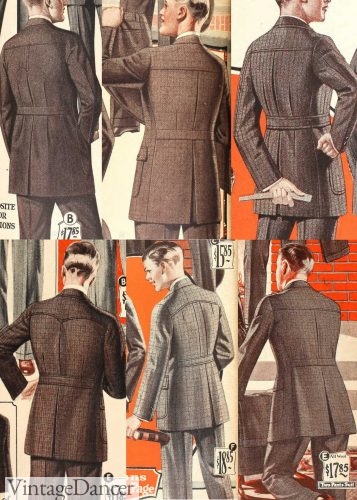
1920s sport suit backs- one-half belts, yoke, pleat, gathered
The Jazz suit trousers were skinny as a pipe, worn brusque to the slightly in a higher place the ankle. They rose high on the waist with a flat, slim fit over the hips and down the legs. Cuffs were optional but most trendy young men added them while older men preferred patently hems.
The matching waistcoat or vest had four to five buttons with four welt pockets and deep points. They did not have collars since calculation them would have added bulk to the breast.
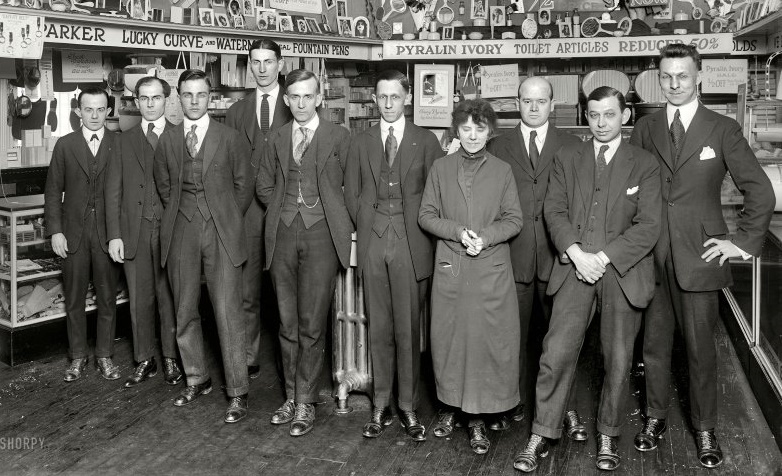
1921, drugstore employees wearing slim fitting mail-war suits. These are not extreme Jazz Suits simply clearly the influence is there.
Jazz conform colors were masculine and nighttime, such as navy blue, medium gray, and soft brownish. Overall, the colors were ho-hum and bawdy as they had been since before the first World War. Medium blue was the brightest color that grew in popularity throughout the 1920s as a compromise betwixt old and new fashions.
In the summer, lighter wool suits, flannel suits, and linen suits were marketed as being lighter and breathable. Colors were light white, grey, ivory, tan, dark-green and blue-grey.
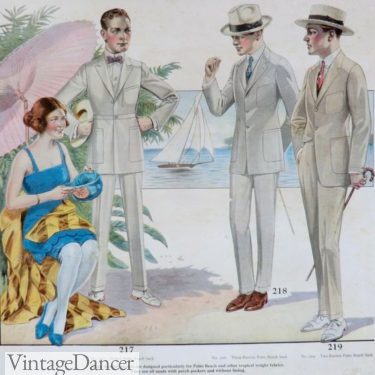
1921 summer Palm Beach suits in the slim fit
Early 1920s men's suits were made of wool, mohair, tweed or corduroy- very thick material compared to today's lighter suiting. It is no wonder men wanted softer, looser, lighter clothing after being stuffed into strong, heavy suits for over a century.
With men returning from war in meliorate physical shape than always, the latest suit was draped to accentuate the lean and muscular physique. The very slim "jazz arrange" disappeared later 1923. The natural body shape was the preferred fashion for most of the 1920s.
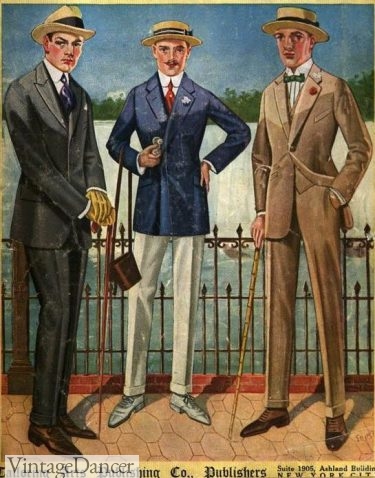
1920 tailored suits for the slim body
The English Suit
Near men's fashion of the roaring twenties came from Great britain. Even Paris, the majuscule of fashion, turned to Britain for menswear inspiration, peculiarly the dapperly dressed prince of Wales. Classy, refined, men of good gustation shopped on Saville Row, where master tailors measured and handcrafted each suit to the owner. Men of means in the The states ordered suits by the dozens from these tailors for every season and with every irresolute trend in mode.
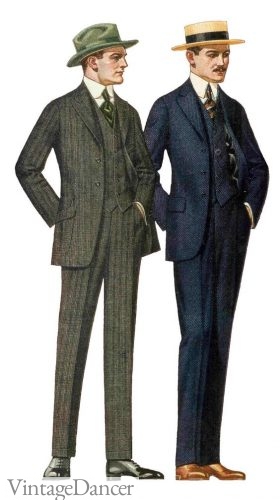
1920 slender just loose shaped suits-a archetype fit
In place of the Jazz suit, men turned to a natural shoulder suit, that was still slim looking, but non nearly as comical. A shorter jacket accentuated a congenital torso and long legs. Older wealthy men continued to shop in London on Saville Row but were looking for an updated suit that was more masculine and plumbing equipment for a mature body. The answer was the British lounge adapt.
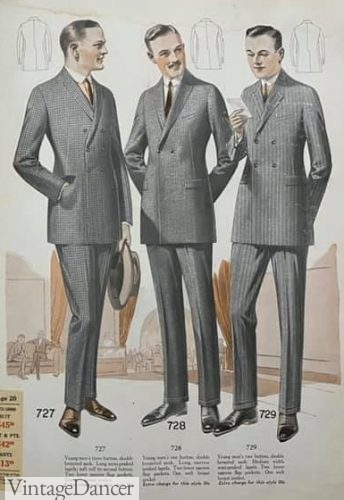
"The English look " that reached summit popularity in 1924, had 3 one/2 inch wide lapels rolled to the tiptop push, natural shaped shoulders, a hip length straight-plumbing equipment loose single breasted jacket, 2 large pockets, and 1 to iv buttons closed at all times. Trousers reached 17 ane/2 inches wide at the hem. Many had pleats but Americans nevertheless clung to the flat font trouser with center printing for most of the decade.
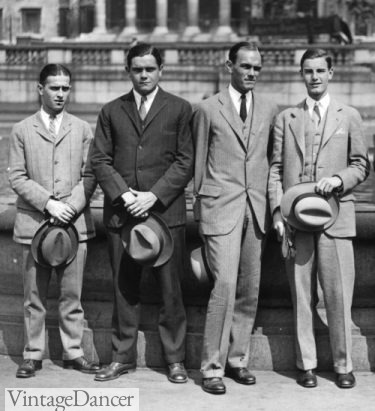
15th July 1925: A grouping of young men from the Special English Speaking Union pose by a fountain in Trafalgar Square, London
Later 1924 the English wait looked more British with a tighter waist and narrow hips. American's like this shape more since it emphasized the broad shoulders of an able-bodied man.
The prince of Wales sported a double breasted grey flannel suit with 3 1/two inch wide lapels in white chalk stripes on his American bout in 1923 and thus fashionable men copied his await. Chalk stripes equally well as glen plaid because his two pattern contributions to the American consumer.
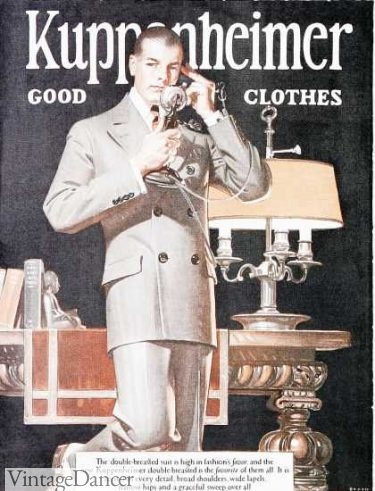
Lath shoulders, narrow hips, inspired the mid 1920s masculine suit. Kuppenheimer clothing (Chicago)
A single or double-breasted 6 to 8 button vest matched the suit with one or ii slit pockets for a pocket sentry on either side. The double breasted 4 push button vest with flap pockets was preferred by traditional men.
Even if the man wore a wristwatch, having a vest without a pocket watch pocket was shoddy.
In Britain, suspenders or braces still held up most pants, however, men were adopting the American leather belt by the mid-1920s. Stout men (big and tall sizes) favored the belt over suspenders.
Bourgeois American suits
While the British liked their shapely suits, the stubborn Americans demanded a more relaxed fit. Conservative American suits were cut straight from shoulder to jacket hem but with a slight curve at the waist, hanging a tad longer, with roomier sleeves and broad shoulders. The shaping of the jacket was made in the dorsum instead of taking in the side seams.
"We are making them now. The shoulders are considerably wider; chest effects are fuller; buttons and pockets are college; coats are snug at the hips and suggest height" said a 1925 Schaffner and Marx suit ad.
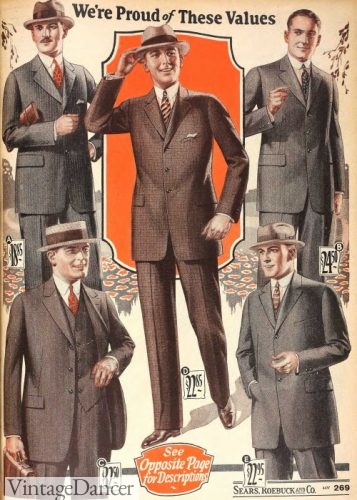
1925 bourgeois American suits
Suits jackets had growing lapels in the 1920s. By the end of the decade it wasn't uncommon to have three and 3/iv inch broad lapels with notch shapes. Peak lapels and double breasted jackets were for the more flamboyant men.
Conform pants favored the natural leg, too, which was almost 17.5 inches wide at the gage (cuffs were ii- 3 inches broad) with very high waists, a button crotch, large pockets, a unmarried crease down the center, and hems that hung around the mid-ankle (revealing socks). It was a archetype pant- non too wide and not also narrow.
Some trousers had pleated fronts (inverted pleat) and wide legs that tapered slowly to the talocrural joint. Men had the option to gage or non cuff pant legs. Cuffed trousers stopped at the talocrural joint while the plainly hem leg was slightly longer.
Suit colors were conservative, just with more patterns such equally thin stripes, windowpane and checks. The suits colors were a fleck bland for the mature man- dark brown, medium grey, dark or navy blue, and black. For young men and summer fabrics blue-gray, grayness-blue, medium brown, grey and tan were popular.
Clothes shirts were white in Britain but striped in America, with colorful horizontal wide striped ties, cap toe Oxford shoes, and felt hats such every bit the Homburg or Fedora. The look was just bourgeois compared to the immature men's Ivy League look, but compared to the previous decade it was downright rebellious.
The Ivy League / Cake Eaters Suits
Later 1924, men, who were by and large young and middle-course Americans, preferred a totally new style that was fifty-fifty more casual and flashy than their father's look. They acquired the "cake eaters" name because these new young kids frequented tea dances where colorful tea cakes were served.
The fashion began at Oxford University and other Ivy League schools in Uk. Well-to-do young American students brought back the manner to the USA, where information technology was eagerly adopted by the majority of young affluent men.
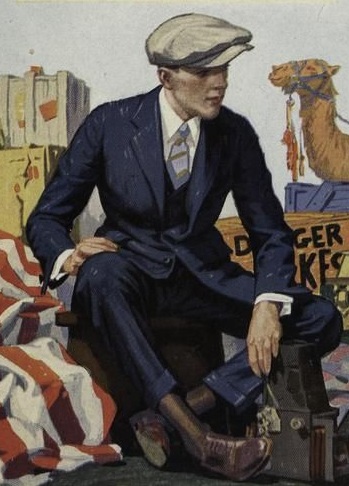
The Ivy League await (also called a drapery cut or blade cutting) was of a slimmer plumbing equipment, single-breasted jacket with slightly narrower notch lapels (2.75 inches), a longer jacket (30.5 inches), 2-3 buttons fasted loftier on the sternum, and large patch pockets placed depression on the front sides. Materials were still very heavy wool or worsted wool, weighing in around 15 oz to the yard.
In 1925 a newer await replaced narrow lapels. The suit jacket was most xl inches long with rounded front skirt and buttons and pockets placed low. Sleeves were full and lapels board and curvy. Most jackets did not have vents. The vest were vi push that came upwards high on the breast. Trousers were wide-cut straight from hip to shoe with a flat front. It was a trendy mode, not 1 to take well with the masses.
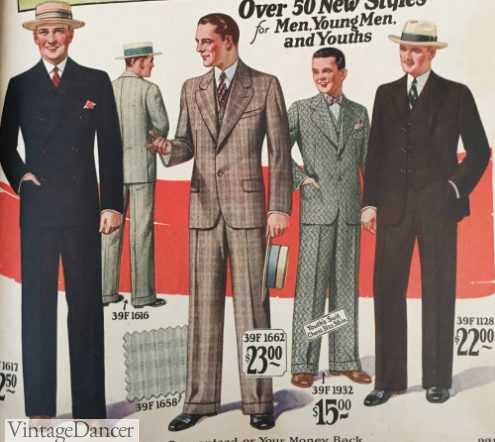
1927 wide suits, dramatic colors and patterns
The British loved their tweed suits, the Americans not and then much. Diagonal tweed suits had a short-lived tendency with lighter shades, called "ice cream suits." Calorie-free tans, creams, blue-greys, grayness-blues, and pinks in pinstripes were made into 3-slice suits and sport coats. They dirtied too easily, withal, and lost favor quickly. Instead worsted wool pinstripes in medium tone colors became common.
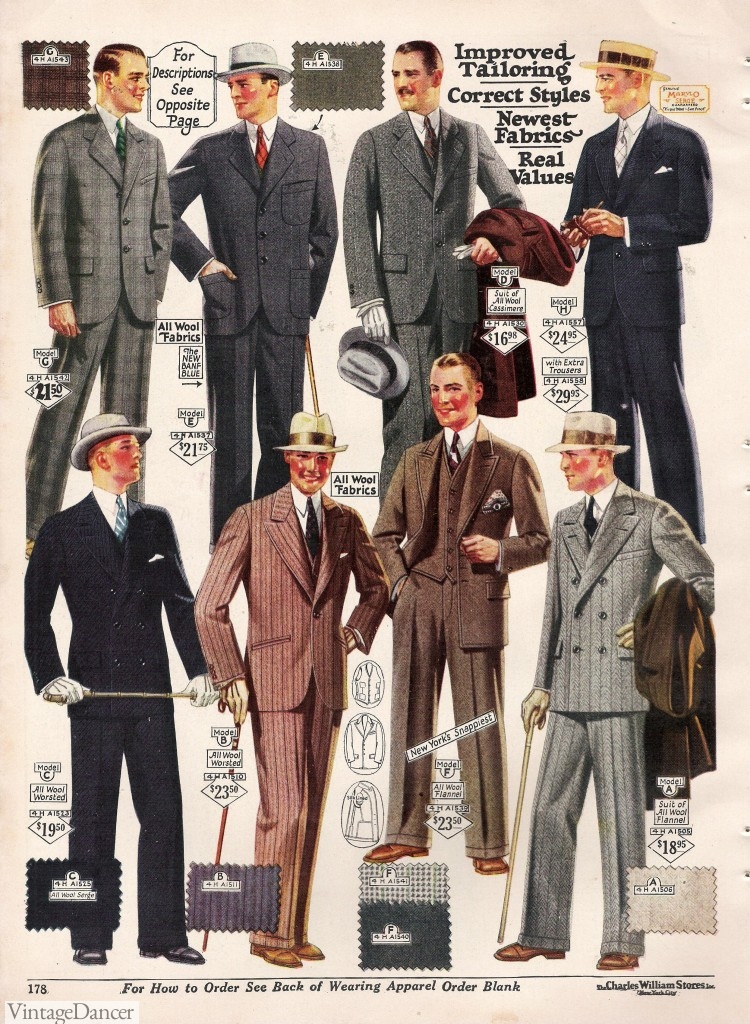
1927 Men's Ivy League Mode Summer Suits in "Ice cream" colors
What really acquired the dramatic difference between conservative and ivy league style was the pants. The young Brits claimed they were widening their pants dorsum to the Victorian age, when men'southward trousers fit looser than in the snug Edwardian teen years. While this is true, they kept on widening pant legs until they formed the "Oxford bag," an extremely wide leg pant that conveniently fit over plus four knickers (that were banned at school).
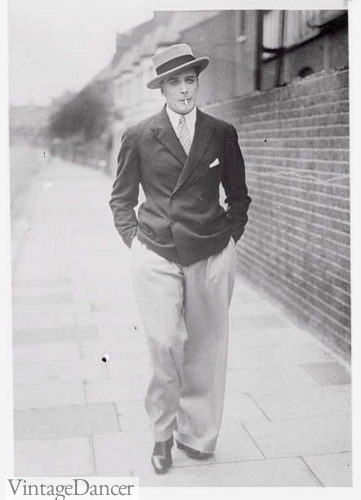
Jack Buchanan 1925 wearing oxford bags with navy sport coat
These baggy trousers were 18 to 22 inches wide merely could go upward to 40 inches wide at the cuff. An invert pleated at the waist for an even fuller appearance. There was only a light taper from knee to talocrural joint, ending at a 2-3 inch gage that broke just at the instep and then as non to break the front leg crease.
Wide leg pants roared into mode in the mid '20s and stayed till the '50s, when trousers returned to the conservative width. The twoscore-inch baggy pant was rare, but overall trousers were wider in the '20s for all who adopted the Ivy league way.
Non-higher kids and centre-class Americans in particular loved the looser, softer Ivy league style. The 3 piece suit came with a matching half dozen button vest either with notch lapels or no lapels and ii-4 pockets. There was likewise a pocketless vest for those young men who preferred to clothing a wristwatch instead of an old fashioned pocket watch.
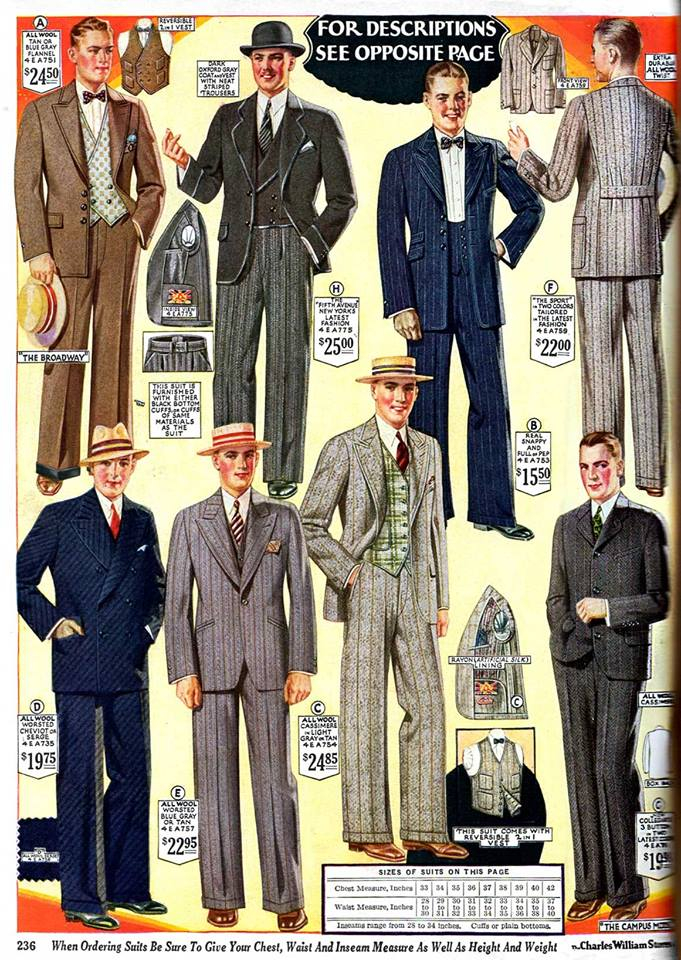
1927 suits with unique vests
In the late 1920s, at that place was also an explosion of many new styles of vests in contrasting colors and prints. Double-breasted, U shaped, and shawl neckband vests made them a focal betoken under opened suit jackets. In the ad to a higher place, a grey plaid belong paired with a grey striped accommodate and a dark-brown adjust was complemented past a grey and white check double-breasted vest. Less extreme examples include a dark grey adjust with a light gray vest or a brown adjust with a tan belong.
The working classes wore whatever vest they could afford to purchase 2d hand, oftentimes in mismatched colors. In this regard, the poor were leading the fashion trends just as much as the rich.
Sportscoats and Summer Suits
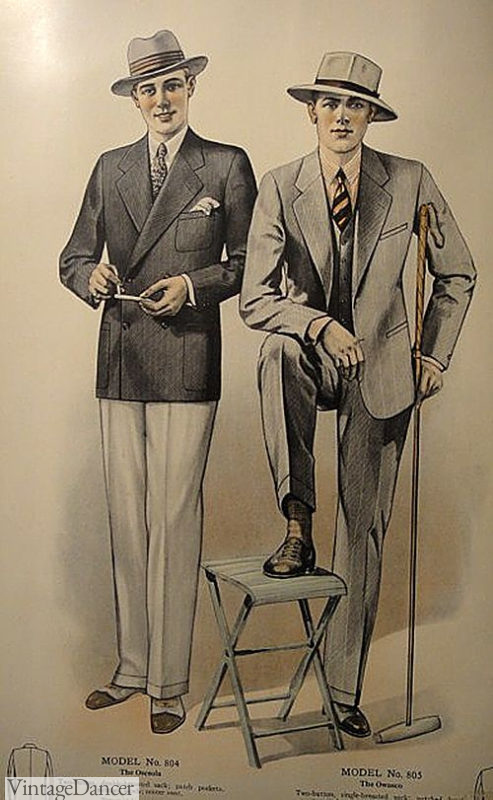
1927 yachting suit of navy blue jacket and white flannel trousers
Wool flannel was ofttimes used in summer suits, although information technology wasn't very cool to vesture. The very posh wore white flannel trousers with a navy blueish flannel jacket at seaside resorts, while cruising across the ocean, yachting, or to attend upper-class sporting events. Pure white was difficult to keep clean, then nigh middle-class men choose ivory, oatmeal or putty-colored flannel trousers instead.
They could also choose the new all-cotton "tub" arrange which could exist washed at domicile in the washing tub and hung to dry. Colors broadened to light greyness, taupe, and tan also every bit darker blueish, greenish and brown.
The coolest textile was linen, followed by a cotton-mohair blend renamed Palm Embankment cloth later on the resort boondocks of Palm Embankment, Florida. They came in white or natural colors. Almost other summer fabric were made of Fresco, a porous, loosely woven wool.
Read more than well-nigh the vintage yachting/cruise/boating look including the iconic striped boater jacket worn not only by athletes just by musicians.
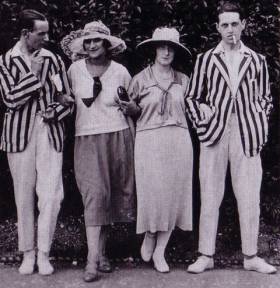
1920 striped boater jackets and white trousers
Suits for Black Men
Were there different suits for men of colour? This is a mutual question I receive and ane which is catchy to answer. About fashion history is written from an upper-grade white perspective with article of clothing retailers marketing to whites only, although mail-order catalogs were used by all races. For the virtually part, American black men wore the same suits every bit white counterparts. Black men dressed too equally they could beget, oftentimes learning to sew and tailor their ain clothing, and making minor adjustments to designs that reflected their personality.
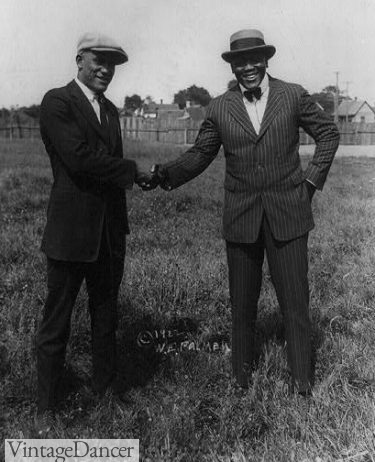
1922 Tut Jackson and Jack Johnson
Working-form men wore work clothes and uniforms 6 days a week, giving fiddling need to dress upward except to church building on Sundays or Saturday night strolls in large cities. When black men did dress up in suits, they were exceptionally fine, ofttimes flashy, and much more colorful than conservative white men.
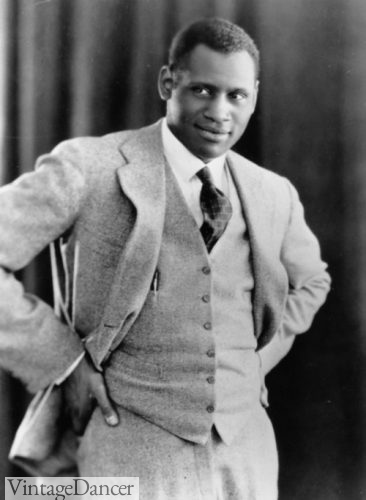
1925 singer and actor Paul Robeson
African American men took the fashion of upper-class white men and improved it with color and fit. In 1927, a boyfriend in Chicago was seen strolling in a pearl grayness lid, spotless gray suit, and a vivid pink and blue moire scarf. Another young man was immaculately dressed with a hatband of blue and white, shoes that were patent leather with white tops, and a flowered waistcoat. Stetson hats were the best brand to article of clothing, angled to one side. Tweed or striped suits fit perfectly with pants that were extra tight in the early years and extra wide in the after years.
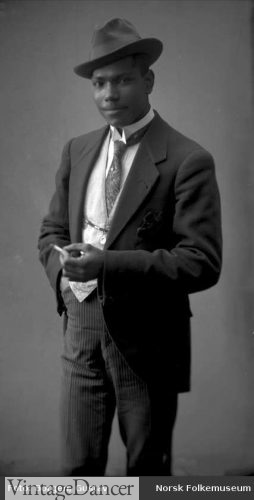
Some reporters called these flashy dressers peacocks or pimps and shamed them for spending their last dime on new apparel, gold jewelry, and diamond-studded teeth like the pop jazzman, Willie "The Lion" Smith. The more conservative pianist Earl Hines looked dapper in a bowler lid, tuxedo, Chesterfield overcoat, walking stick, and coiffed hairstyle. Stylish, expensive, and professional. Musicians were frequently selected to play at jazz clubs based on what they wore. Beingness impeccably dressed meant getting a gig that afforded the adjacent wardrobe purchase — or not, and pawning it for half toll the following week.
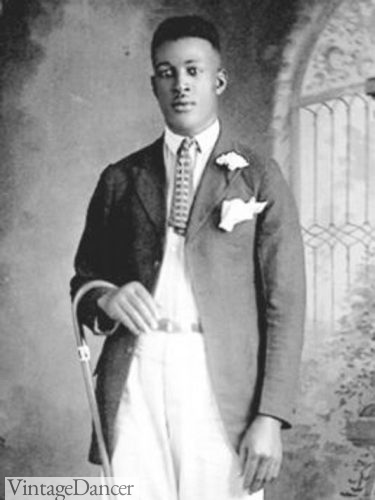
In some moderate communities, men might have worn pants and jackets that were mismatched with brightly colored shirts, scarves, ties, and shoes. Cerise, yellow, light green, calorie-free blue, and processed pink shirts were favorite colors. Even suspenders were "loud" and designed to be seen, non hidden, under vests.
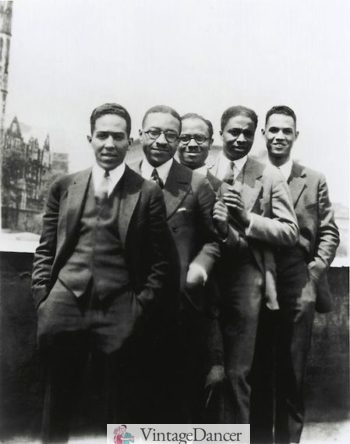
1924 from left to right Langston Hughes, Charles S. Johnson, E. Franklin, Frazie Rudolph Fisher, and Hubert T. Delany in conservative suits
Of grade, non every African American man dressed flashy. The wealthier he was or when in the presence of white people, the greater the effort to blend in by wearing conservative suits with dark blood-red, green, black and white accessories. College students, for example, were usually more dressed up but conservative, than the white students.
A modern-day vintage peacock is Groovy Wellington whose 20s-40s inspired style is impeccable.
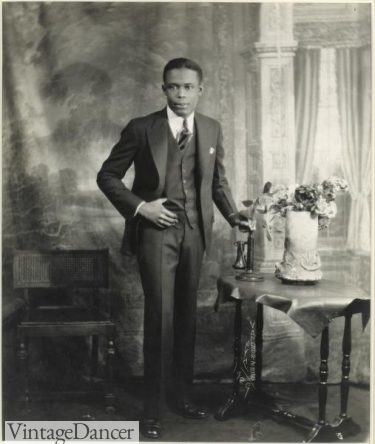
James VanDerZee, Studio Portrait of Young Man with Telephone, 1929
1920s Suits on Television
If you lot actually want to meet 1920s men'due south suits in action, you should watch HBO's Boardwalk Empire. The costume designer had suit fabrics recreated from original '20s garments and then used authentic patterns from the era to produce several of each adapt worn in the evidence. The historical accuracy brings the testify to life, as well as giving us an excellent reference for menswear in the early to mid '20s.
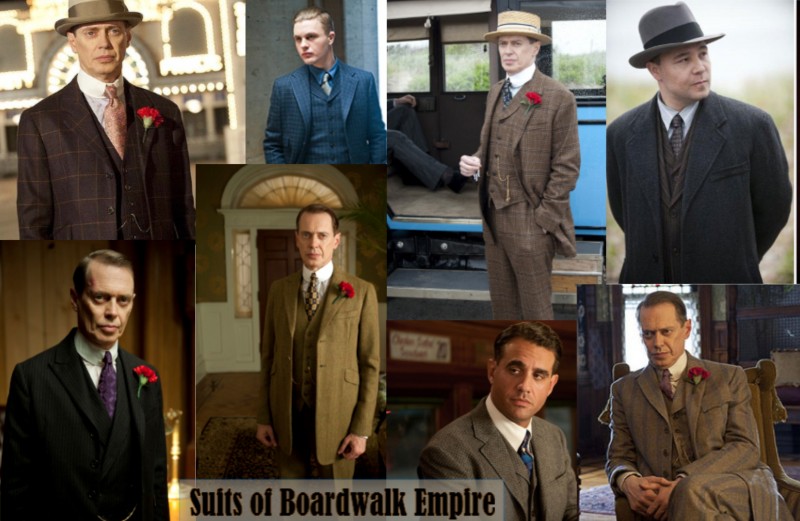
The Men's Suits of HBO'southward Boardwalk Empire- set in the early 1920s
Peaky Blinders is another popular Television show with many men's suits to adore, although non as accurately as Boardwalk Empire. See this article on creating a Peaky Blinders outfit.
The last two seasons of Downton Abbey were also set in the mid-1920s and have some British upper-form men's fashions to savor.
The Peachy Gatsby motion-picture show (2013) is hardly authentic to the era, but it does prove you what it looks like to accommodate new wearable into an inspired '20s style. The original 1970s The Great Gatsby movie is a petty more than accurate.
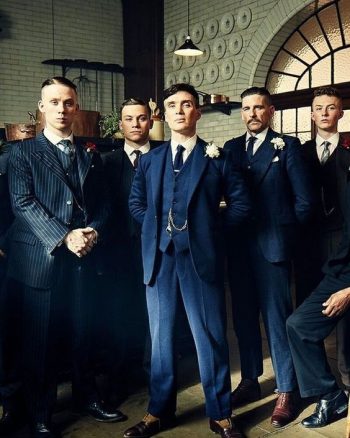
Peaky Blinders, 1925 – Blue suits for all
Evening Suits
Larn about men'due south tuxedos, wedding suits and formal morning suits in this commodity.
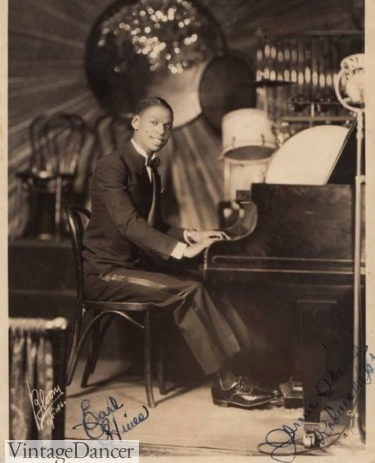
1929, Earl Hines, wears tuxedo pant with silk stripe
Choosing a 1920s Suit for You lot
Putting the very small vintage 1920s suit bated, your options for dressing in a 1920s suit today leaves you lot with either ownership a reproduction 1920s suit ($500 and up) or a new vintage-inspired suit. Archetype men's suits will lack some of the details that brand 1920s men'southward suits unique but if you lot focus on the cut, colour, and blueprint you lot can accomplish a similar look to the era at half the cost.
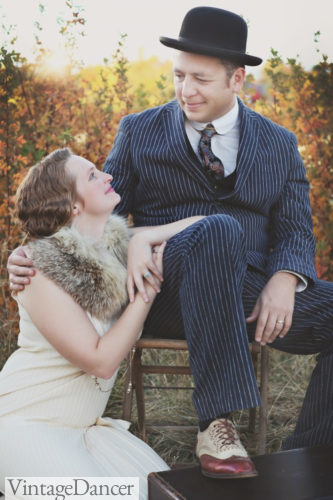
Striped linen suit past Perry Ellis
Outset, you must decide if you want an early '20s slim suit or late '20s wide suit. The early 20s expect mimics the current slim fit tendency today, and so as long every bit you don't go for the ultra slim fit/stretch skinny fit suits, you lot will not be too far off. The main divergence is in the low ascent of the pants and the lower V opening of the jacket. I have good luck finding classic fit suits at Brooks Brothers, Paul Fredrick, and Perry Ellis.
For a broad fit suit, you lot will need to look at imported Italian suits or urban men'due south fashion suits (brand Stacy Adams and similar). They tend to look more "gangster" than archetype fit suits, especially in nighttime colors and wide stripes. Online MensUSA, MensItaly and Stacy Adams will accept some good options. Sometimes you can find them on Amazon as well.
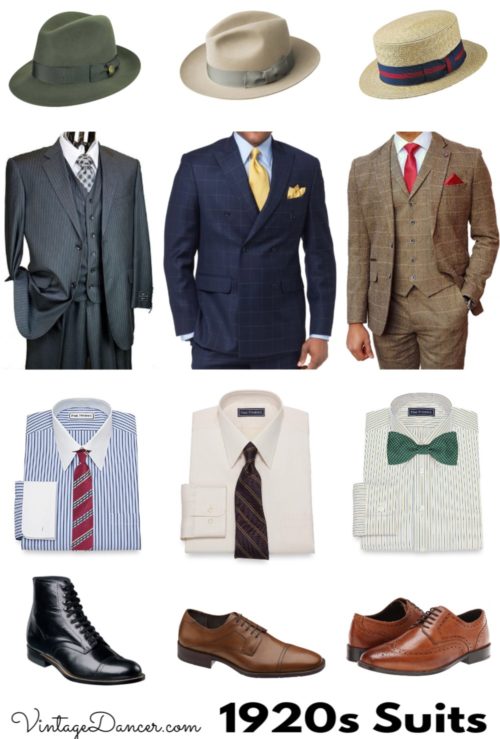
1920s men's suit, hat, shirt, tie and shoe combinations
Colors/Textures of 1920s suits are what gives them the vintage look. I look for wide or thin stripes, windowpane, plaid, checks, tweed or textured wool. Choose navy blue, medium blue, night to calorie-free tan, dark or light grey and medium or light greenish. Avoid solid black, skinny lapels, and pants that are too short. In summer, a skilful seersucker or linen alloy suit is very absurd and comfortable.
Finally, don't be afraid of color. Cull accessories that do not match the suit. Brown or blackness shoes go with all suit colors. Hat colors can be whatever shade of brown, grayness, blue, light-green, tan, cream or blackness. Shirts should have some color as well as a brightly colored tie. If color scares you, and then cull shades of the same colour family unit- i.e. navy blueish suit, calorie-free bluish shirt, medium blue tie, etc.
Here are some of the suits Oscar has worn to 1920s events:
More than 1920s Men's Outfit Inspiration
Shop 1920s inspired men'due south suits
These suits were chosen for either the cut/fit or the color/pattern that closely resembles vintage 1920s men's suits. Wearing a adjust with the correct hat, shoes, and accessories will instantly have you lot back in time.
0 Response to "Conservitive Suit Colors Mens Frugal Fashion"
Post a Comment